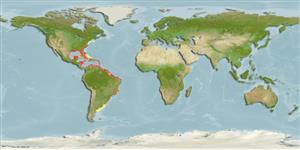>
Eupercaria/misc (Various families in series Eupercaria) >
Gerreidae (Mojarras)
Etymology: Eucinostomus: Greek, eu = good + Greek, kyon = dog + Greek, stoma = mouth (Ref. 45335).
More on authors: Quoy & Gaimard.
Environment: milieu / climate zone / depth range / distribution range
पारिस्थितिकी
समुद्री; स्वच्छ जल, अलवण जल; खारा प्रवाल-भित्ति संयुक्त; गहराई सीमा 0 - 55 m (Ref. 26912). Subtropical; 43°N - 51°S, 98°W - 34°W
Western Atlantic: Massachusetts, USA and Bermuda to Argentina; including the Gulf of Mexico and the Caribbean Sea (Ref. 9626).
Length at first maturity / आकार / वज़न / Age
Maturity: Lm 11.0 range ? - ? cm
Max length : 25.5 cm TL पुल्लिंग / अलिंग; (Ref. 111768); common length : 15.0 cm TL पुल्लिंग / अलिंग; (Ref. 3722)
पृष्ठीय रीढ़ (सम्पूर्ण): 9; पृष्ठीय सौफट रेज़ (सम्पूर्ण): 10; गुदा कांटा 3; ऐनल सौफट रेज़: 7
Inhabits shallow waters, being especially abundant over mud bottoms in mangrove-lined lagoons or creeks; larger individuals may also occur on vegetated sand grounds in marine areas. Enters fresh water in limestone regions (Ref. 7251). May occur in aggregations (Ref. 3722). Probably feeds on small benthic invertebrates (Ref. 3722). Marketed fresh but not highly esteemed (Ref. 3722).
Robins, C.R. and G.C. Ray, 1986. A field guide to Atlantic coast fishes of North America. Houghton Mifflin Company, Boston, U.S.A. 354 p. (Ref. 7251)
IUCN Red List Status (Ref. 130435)
Threat to humans
Harmless
Human uses
मात्स्यिकी: लघु वाणिज्य; ठहराव / प्रलोभन: usually
अधिक जानकारी
संदर्भजलीयकृषिजलीयकृषि रूपरेखाखींचआनुवंशिकीElectrophoresesहैरेटिबिलटीबीमारीप्रक्रमणNutrientsMass conversion
साधन
Special reports
Download XML
इंटरनेट स्रोत
Estimates based on models
Preferred temperature (Ref.
123201): 22.8 - 28, mean 25.5 °C (based on 504 cells).
Phylogenetic diversity index (Ref.
82804): PD
50 = 0.5010 [Uniqueness, from 0.5 = low to 2.0 = high].
Bayesian length-weight: a=0.01096 (0.00924 - 0.01302), b=3.08 (3.04 - 3.12), in cm total length, based on LWR estimates for this species (Ref.
93245).
Trophic level (Ref.
69278): 2.7 ±0.1 se; based on diet studies.
लौटाव (Ref.
120179): माध्यम, न्यूनतम जनसंख्या दुगनी होने का समय 1.4 - 4.4 वर्ष। (K=0.3).
Fishing Vulnerability (Ref.
59153): Low to moderate vulnerability (32 of 100).
Nutrients (Ref.
124155): Calcium = 41 [15, 82] mg/100g; Iron = 0.587 [0.266, 1.134] mg/100g; Protein = 19.8 [17.8, 21.8] %; Omega3 = 0.224 [0.114, 0.430] g/100g; Selenium = 13.7 [6.2, 27.5] μg/100g; VitaminA = 49.3 [12.6, 191.8] μg/100g; Zinc = 1.22 [0.77, 1.92] mg/100g (wet weight);
